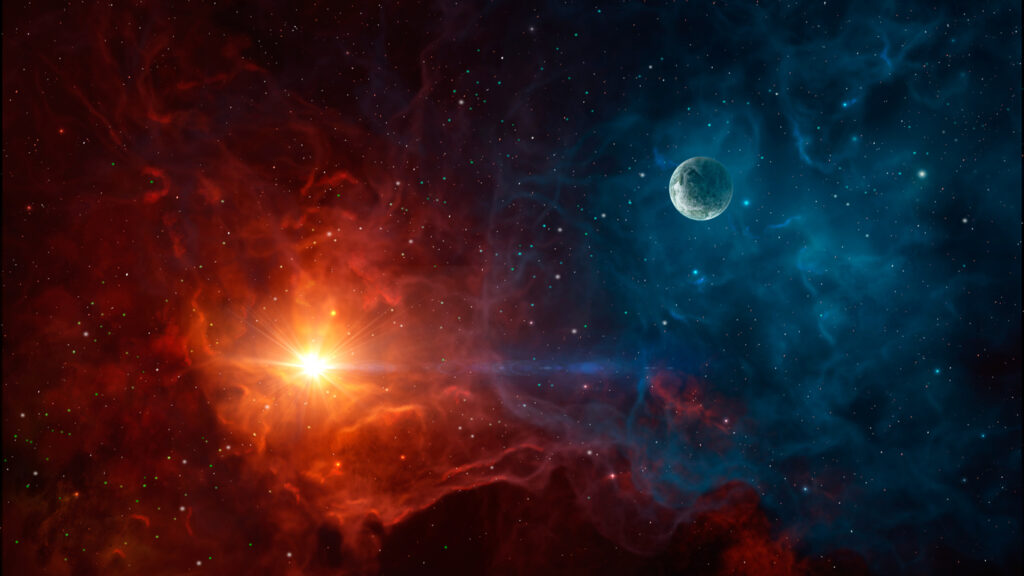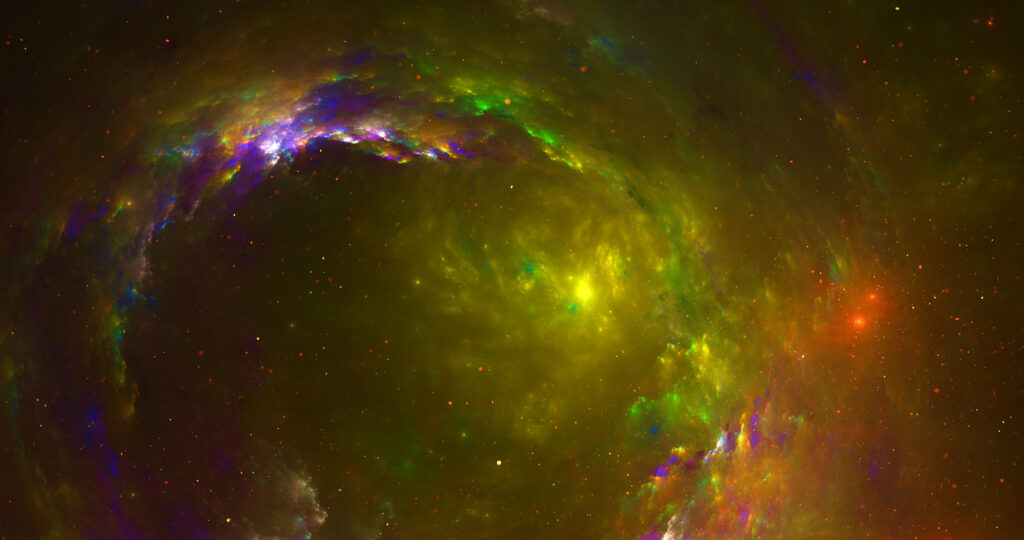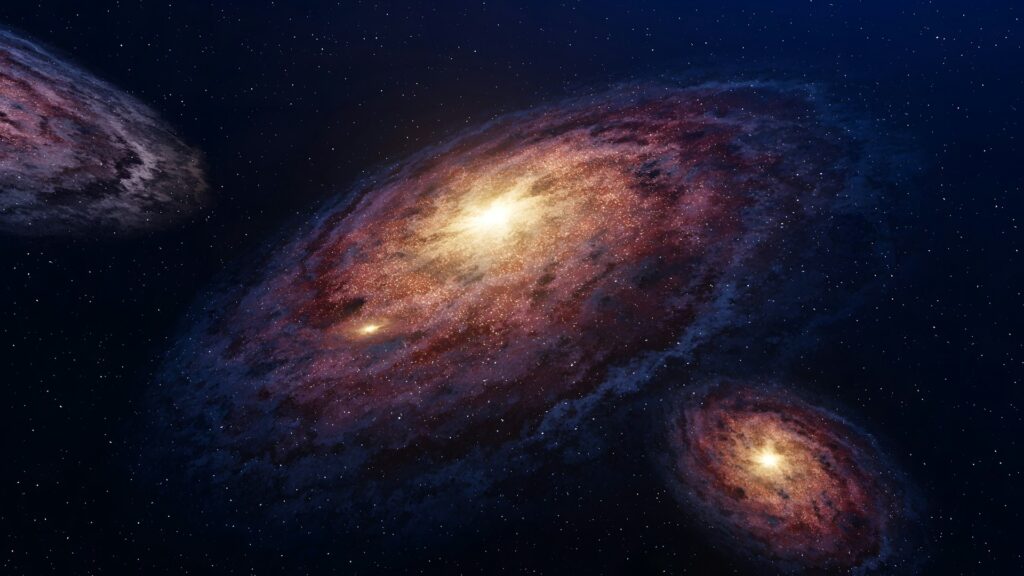
Dark matter is already weird — invisible, untouchable, and seemingly everywhere. However, scientists are now asking if it might be even stranger than we thought. What if, instead of just floating through the universe without interacting, some dark matter is sticky? The idea that dark matter particles might bump into each other and drag ever so slightly could help explain some of the odd behaviours we see in galaxy collisions. It’s still just a theory, but it could seriously change how we understand gravity, galaxies, and the shape of the universe itself. Here’s what scientists mean when they talk about “sticky” dark matter, and why it might actually be a thing.
Most dark matter models say it’s collision-free.
The standard theory says dark matter doesn’t interact except through gravity. It doesn’t clump, doesn’t bounce off anything, and just passes straight through other particles, including other dark matter. That’s how it explains large-scale structures in the universe without messing with normal matter too much.
This has been the go-to model for decades because it fits the data we’ve seen so far. However, it doesn’t explain everything, and that’s where the idea of “sticky” dark matter comes in. If dark matter could bump into itself just a tiny bit, it might help us make more sense of some of the strange things we’ve observed.
Some galaxy clusters aren’t behaving as expected.
When two galaxy clusters crash into each other, the stars and dark matter are expected to move right through, while hot gas clouds slow down. That’s exactly what we see — usually. However, in some clusters, the dark matter appears to lag or bunch up in ways we can’t fully explain.
One of the most famous examples is Abell 520, where a large clump of dark matter was observed without any associated stars. That’s weird. If dark matter is meant to be collisionless, it shouldn’t be slowing down or hanging back. Something else might be going on.

Abell 3827 showed a noticeable offset.
In 2015, researchers studying the Abell 3827 galaxy cluster spotted a dark matter blob that was slightly behind the galaxy it belonged to. We’re talking about a difference of 5,000 light-years — small on a cosmic scale, but big enough to raise eyebrows.
That kind of displacement doesn’t fit cleanly with traditional models. The only way to explain it might be if dark matter particles are occasionally interacting with each other, causing drag. It’s far from conclusive, but it definitely sparked renewed interest in the idea of self-interacting dark matter.
Sticky dark matter could solve some other puzzles.
Astrophysicists have long noticed that the way dark matter clusters around small galaxies doesn’t always match what simulations predict. Simulated galaxies often have overly dense “cuspy” cores, while real galaxies appear to have more spread-out centres.
If dark matter particles occasionally bounce off each other, it would help smooth out those dense areas — giving us the fluffier cores we actually observe. That would make sticky dark matter a neat solution to the so-called “core-cusp problem” in cosmology.
The latest surveys show it’s probably not that sticky.
While early studies like Abell 3827 sparked excitement, more recent observations have taken a broader view. A large survey of 72 galaxy collisions using data from the Hubble Space Telescope and Chandra X-ray Observatory found no strong evidence of dark matter dragging or clumping.
That doesn’t rule out stickiness entirely, but it does suggest that if self-interaction exists, it’s extremely subtle. So we’re not talking about honey-thick space goo — more like the occasional tap on the shoulder between particles drifting in the dark.

The concept is still being taken seriously.
Even with mixed results, scientists haven’t dropped the idea. The sticky version of dark matter is now officially called self-interacting dark matter (SIDM), and it’s still being tested in simulations and particle models. It could involve entirely new forces or particles we haven’t discovered yet.
One popular theory is that dark matter might interact through a “dark photon,” similar to how regular particles interact via electromagnetism. It’s purely theoretical, but it opens up exciting possibilities for what else could be lurking in the universe’s hidden side.
Not all clusters follow the same pattern.
It’s important to note that not every galaxy cluster supports the sticky theory. Some, like the famous Bullet Cluster, behave exactly how standard models predict, with dark matter sailing straight through without hesitation.
But then you have exceptions like Abell 520 and Abell 3827 that throw a wrench in the works. The challenge is figuring out whether these oddballs are due to sticky dark matter, or just complex, messy cosmic collisions that don’t fit neatly into any model yet.
It would change how we look for dark matter.
If dark matter really can interact, even weakly, that would narrow down the list of possible particles scientists are hunting for. It would rule out some of the more exotic candidates and favour ones with specific kinds of short-range forces or extra dimensions.
It could also influence how we design dark matter detectors here on Earth. We’ve mostly been looking for invisible particles that barely react, but if there’s even a hint of interaction, it could reshape the experiments entirely.

Computer models are helping test the idea.
Researchers are running massive computer simulations to see how galaxies would evolve if dark matter had self-interactions. In some cases, these simulations match real galaxies better than the collisionless models do. They help fine-tune the levels of stickiness that might still fit the data — enough to affect galaxy structure, but not so much that it messes with large-scale cosmic evolution. It’s a delicate balance, but a promising avenue for testing the theory further.
Right now, it’s still up for debate.
At the moment, sticky dark matter remains a possibility, but not a confirmed one. The best guess is that if it’s real, the effect is incredibly faint. But even that faint interaction could answer some big questions about how galaxies form, evolve, and hold together.
So no, we haven’t caught dark matter red-handed just yet. But the fact we’re even asking whether it might have stickiness shows just how much the field is evolving. And who knows? The more we peer into the dark, the more surprises the universe might throw our way.